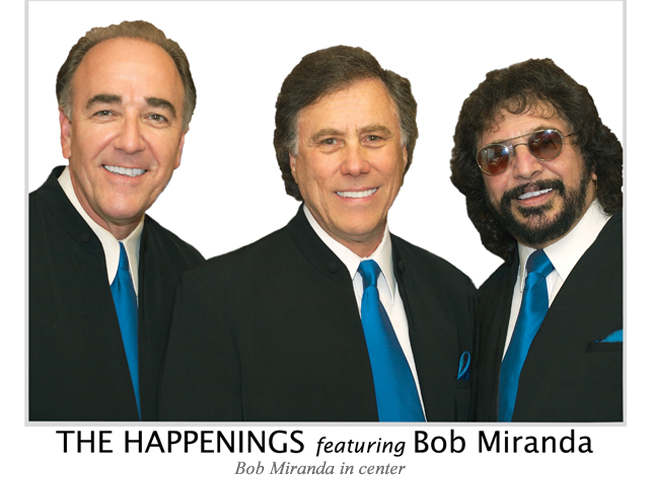The Happenings on How the Slightest Thing Can Make a Difference

Sometimes the slightest thing can make all the difference. In the case of The Happenings, it was a simple suggestion — “Why don’t you guys try doing this song?” — that song lifted them from obscurity to success.
* * * * *
“When I was a kid in 1952, I remember my aunt swooning over Johnnie Ray. He threw off his jacket and, oh my God, she went crazy. I had never seen that kind of energy and connection before.” So says Bob Miranda — lead singer of The Happenings — about his first exposure to the power of music and performance to move someone.
In his teens Bob became captivated by the group harmony sounds of The Four Freshmen — whose highly complicated vocal arrangements influenced many future stars, most notably Brian Wilson of The Beach Boys — as well as those of Frankie Lymon and The Teenagers. “I loved Frankie Lymon’s stuff,” he says. “Some of my favorite groups, like The Four Seasons and The Tokens, had that falsetto lead.”
And so, when an impromptu boy’s room acapella session at a church dance in East Paterson, NJ between several guys showed promise, Bob and his Central High buddy Ralph DeVito teamed up with Eastside High’s Tom Giuliano and Harry Arthur as The Four Graduates. (Another Eastsider, Dave Libert, replaced Arthur in 1964.)
The Graduates hit the road, performing many times in the Catskills hotels. “We were pretty schmaltzy,” says Bob “We flip-flopped between standards and early rock ’n’ roll.”
The group’s first label stop was Rust Records, which had had its initial chart success in the summer of 1963, when Randy & The Rainbows scored with “Denise,” a record produced by The Tokens.
Released at the same time, The Four Graduates “A Lovely Way To Spend An Evening” did not enjoy the same fate. Their second Rust single arrived 15 months later with equally disappointing results.
Still, there was movement behind the scenes. “We worked with (songwriter/producer/label owner) Bob Crewe doing a lot of background things: ‘oohs’ and ‘aahs’ and background harmony things to the instrumental tracks. There was no lead vocal so we didn’t know who they were for. It may have been some of Mitch Ryder’s or Eddie Rambeau’s stuff.
Bob also signed a staff songwriter deal. “I ended up at The Tokens’ office one day [in 1964],” says Bob, “and did an audition with my guitar of some of the songs that I had written, and they hired me as a staff writer for their B.T. Puppy label, which was 50% Jubilee [Records] and 50% The Tokens.
“They were looking for artists, so I brought in my Four Graduates. I don’t remember what songs we sang for the audition, but they loved us. We kind of sounded like them.”
After choosing a more contemporary, “happening” name, Bob and group released their first B.T. Puppy single in the spring of 1966. “‘Girls On The Go’ had [some] falsetto and my natural voice,” Bob recalls. “It was a big hit in Springfield (Massachusetts) and nowhere else.”
Then came a suggestion from Mickey Eichner, a vice president at Jubilee Records: “Why don’t you guys try doing ‘See You In September?’ We said, ‘We’re looking for more of a rock ’n’ roll sound.’ I thought it was a great song, but the [Tempos original 1959] record was kind of boring to me.”
“We picked it apart and added all of those little vocal hooks and the falsetto, and gave it sort of a Motown sound: a ‘fours’ feel on the snare. After we had finished the vocals and the form of the song, Herb Bernstein embellished instrumentally around [what] we had created.”
In mid-June 1966, “See You In September” broke out in New York City and the Northeast, spread across America, and peaked at #1 on Record World’s 100 Top Pops chart in, appropriately, September.
For Bob, it wasn’t just “a little summer song.” “I get so many vets who come up to me and say, ‘You have no idea what ‘See You In September’ meant to me in Vietnam. It gave us hope that we might get home.’ It’s incredible that something I did in the studio had that kind of meaning to somebody.”
After “September,” the formula for subsequent Happenings releases was set: put a falsetto-lead-with vocal-hooks spin on an older hit song. Thus, “Go Away Little Girl” (Steve Lawrence, 1963), “I Got Rhythm” (1930, from the musical Girl Crazy), “My Mammy” (from 1918, popularized by Al Jolson), “Why Do Fools Fall In Love” (Frankie Lymon and The Teenagers, 1956), “Music! Music! Music!” (Teresa Brewer, 1950), and “Breaking Up Is Hard To Do” (Neil Sedaka, 1962).
Of these, Bob’s favorite is “I Got Rhythm.” “I wrote the intro and I changed one of the verses. I thought it was so ballsy to add to or rewrite Gershwin. I was scared to death that I was going to get sued, but, I never heard anything about it!’
“When we [listened] to the playback [in the studio], all of our jaws dropped. We said, ‘My God, if that’s not a number one, I don’t know what is.’ We all believed in it.” Their faith was well placed: “Rhythm” went all the way on the Cash Box Top 100 in June 1967.
By 1969, the one-time fans of Top 40 music had shifted their attention to psychedelic and blues-based heavy rock and that, combined with decline of The Happenings’ record labels, meant failing fortunes for the group. Miranda and Libert wrote and produced Piece Of Mind, a final, concept album designed for the FM radio and album audience that unfortunately, got no traction in the marketplace.
The Happenings’ last hit was the “Where Do I Go/Be-In/Hare Krishna” medley from Hair, which went Top 30 in Record World, #2 in St. Louis, and #2 in New York City.
* * * * *
This year marks the 50th anniversary of Bob and The Happenings’ national debut and he shows no signs of stopping. “I still get inspired by audiences,” he says. “I can see the memories in their eyes coming back to them when we do certain songs.”
He’s particularly fond of the Malt Shop Memories Cruise fans. “I love them because they are not there just for the cruise: they’re there for the music and to meet the people who made those records, and to share stories of what a certain song meant to them at a certain time in their life.”
- Ed Osborne © 2016
